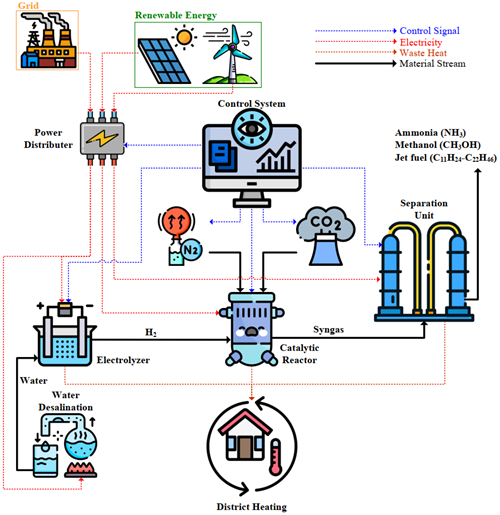Over the years, the aggressive pursuit of energy efficiency, system integration and renewable energy generation has moved the European allies close to a fossil-free energy system. The subsequent step of this move is the decarbonization of industry, heating, and transportation through both indirect and direct electrification. The apparent and natural conclusion of this adventure is hydrogen (H2), which holds a remarkable potential for reducing carbon dioxide (CO2) emissions in hard-to-abate sectors. The blanket term of Power-to-X refers to a set of technologies converting renewable electricity into other forms of energy carriers, specifically when the direct electrification is not possible. The term X is used to signal that the energy carrier is not essentially H2 and to represent different products or energy carriers such as methane (CH4), ammonia (NH3), methanol (CH3OH), synthesis fuels (kerosene or jet fuel, petrol, diesel, other derivative) etc. generally called e-fuels. Indeed, almost all of today’s H2 demand is supplied by fossil fuels such as natural gas through the direct and indirect mechanism Autothermal Reforming (ATR) process (Blue-H2) and coal through a coal gasification process (Brown-H2). Both processes are accompanied by the carbon capture and utilization (CCU) technology with the pre-combustion CO2 capture (PCC) approach to remove the CO2 from the final syngas stream to reach a high purity and quality H2 with high efficiency. Even though the H2 production industry is dominated by fossil-fuel based processes, exploiting renewable energies such as wind, solar and hydro power in the production of H2, which is generally called Green-H2, it is an effective way to combat the global warming disaster. In addition, there is a tremendous amount of waste heat available in the H2 derivatives production processes and the electrolyzer itself that can be recovered and utilized within the process and even integrated in the district heating network. Nevertheless, the intermittency nature of the Green-H2 makes it challenging to have a sustainable process.
This PhD project is targeting the design of energy-efficient and sustainable e-fuel production (NH3, CH3OH, and jet fuel processes). The basic principle of Power-to-X is that the renewable electricity is used in one or a set of operational units called electrolyzer to split water into O2 and H2 through an electrolysis process. Then, the Green-H2 can be used directly or substituted by the fossil fuel-based H2 in the generation of NH3, CH3OH, and jet fuel to reduce the reliance of these industries’ fossil fuel. First, a meticulous chemical process design taking all aspects of chemical engineering from the thermodynamic Equation of States (EOS) and Activity Coefficient Models (ACM) to the Reaction Kinetics, Reactor Design and Separation processes by Absorption and Distillation methods are taken into consideration with the aim of obtaining results with minuscule deviation from reality. Subsequently, upon designing the process chemically, an energy analysis by the Pinch Design Method (PDM) will be conducted on the whole process to find the optimum Heat Recovery Approach Temperature (HRAT) where the waste heat recovery within the process is maximum, and an optimal thermal network will be designed for the process in that HRAT. Further investigation in this phase is to locate the areas in the optimal thermal network of the process where high temperature waste with desired temperature is available to be integrated into the district heating network. Eventually, a dynamic study will be carried out to come up with solutions for periods where renewable sources cannot provide adequate electricity to keep the condition of the process steady state. This intermittency acts like a disturbance to the whole process, and the aim of this task is to control the determining design parameters that holds the whole process at its optimum condition and to project the exact time it takes the process to get back to its optimum steady state or even better: its sustainable condition. A comprehensive figure considering all the objectives of this project is demonstrated in fig. 1.

Fig. 1. Simplified schematic of the sustainable e-fuel production process.
This project is supervised by Associate Professor Ali Khosravi.
Contact information
PhD student: Mohamad Reza Malekli, malekli@sdu.dk, phone: +45 91967375.